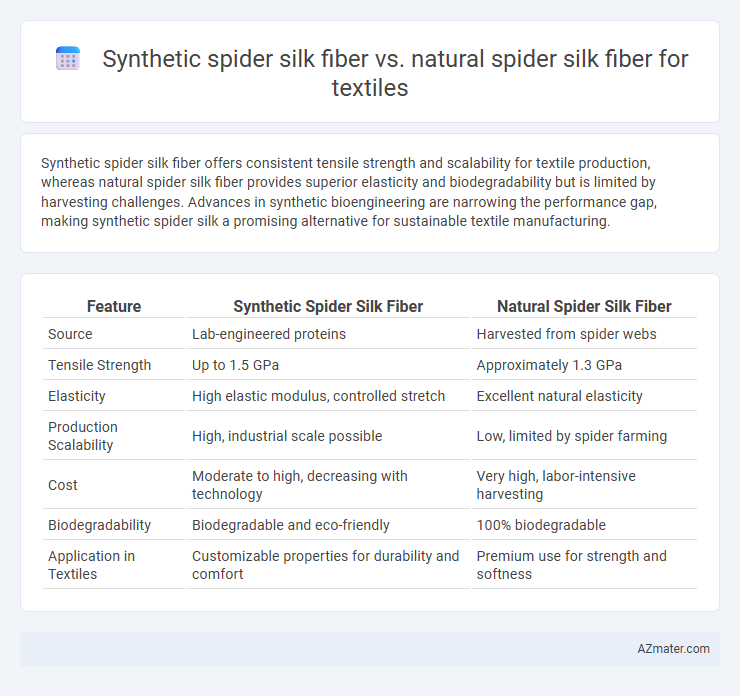Synthetic spider silk fiber offers consistent tensile strength and scalability for textile production, whereas natural spider silk fiber provides superior elasticity and biodegradability but is limited by harvesting challenges. Advances in synthetic bioengineering are narrowing the performance gap, making synthetic spider silk a promising alternative for sustainable textile manufacturing.
Table of Comparison
| Feature | Synthetic Spider Silk Fiber | Natural Spider Silk Fiber |
|---|---|---|
| Source | Lab-engineered proteins | Harvested from spider webs |
| Tensile Strength | Up to 1.5 GPa | Approximately 1.3 GPa |
| Elasticity | High elastic modulus, controlled stretch | Excellent natural elasticity |
| Production Scalability | High, industrial scale possible | Low, limited by spider farming |
| Cost | Moderate to high, decreasing with technology | Very high, labor-intensive harvesting |
| Biodegradability | Biodegradable and eco-friendly | 100% biodegradable |
| Application in Textiles | Customizable properties for durability and comfort | Premium use for strength and softness |
Introduction to Spider Silk Fibers
Spider silk fibers, both synthetic and natural, exhibit exceptional tensile strength and elasticity, making them ideal for advanced textile applications. Natural spider silk is renowned for its lightweight, biodegradable properties and high protein content, primarily fibroin, which grants superior mechanical performance. Synthetic spider silk fibers, engineered through recombinant DNA technology, aim to replicate these traits with enhanced scalability and consistency, offering promising alternatives for sustainable textile manufacturing.
Composition and Structure: Natural vs Synthetic Spider Silk
Natural spider silk fiber consists primarily of fibroin proteins arranged in a hierarchical structure of beta-sheet nanocrystals embedded in an amorphous matrix, providing exceptional tensile strength and elasticity. Synthetic spider silk fiber aims to replicate this protein composition through recombinant DNA technology and biomimetic spinning, but often lacks the precise molecular alignment and nano-architecture found in natural silk. These structural differences critically influence the mechanical properties, with synthetic fibers still evolving to fully match the toughness and biodegradability inherent in natural spider silk.
Production Methods: Harvesting vs Bioengineering
Synthetic spider silk fiber production relies heavily on bioengineering techniques, using genetically modified microorganisms such as bacteria, yeast, or plants to produce silk proteins in controlled bioreactors. Natural spider silk fiber harvesting involves collecting silk directly from live spiders through meticulous and labor-intensive processes, limiting large-scale production due to spiders' territorial and cannibalistic behavior. Bioengineered synthetic silk offers scalable and consistent fiber quality, addressing the inefficiencies and variability inherent in natural spider silk harvesting.
Mechanical Properties: Strength and Flexibility Compared
Synthetic spider silk fiber exhibits tensile strength comparable to natural spider silk, often reaching up to 1.2 GPa, while offering enhanced consistency due to controlled manufacturing processes. Natural spider silk fibers provide exceptional elasticity, with elongation at break percentages typically between 30-50%, surpassing most synthetic variants in flexibility. Both materials excel in combining lightweight properties with high toughness, but synthetic fibers are increasingly optimized to mimic or exceed natural spider silk's mechanical performance for advanced textile applications.
Environmental Impact of Production
Synthetic spider silk fiber production relies heavily on petrochemical resources, generating significant carbon emissions and non-biodegradable waste. Natural spider silk fiber is produced biologically by spiders, resulting in a renewable, biodegradable material with minimal environmental footprint. However, scaling natural spider silk for textiles faces challenges due to low yield and intensive labor, prompting research into sustainable biotechnological synthesis methods.
Cost and Scalability: Synthetic vs Natural
Synthetic spider silk fiber offers significantly lower production costs and higher scalability compared to natural spider silk, which requires labor-intensive farming and yields limited quantities. Advances in biotechnology enable mass production of synthetic variants through microbial fermentation or bioreactors, reducing time and resource demands. This scalability makes synthetic spider silk fiber more viable for large-scale textile manufacturing and commercial applications.
Applications in Textile Industry
Synthetic spider silk fiber offers enhanced scalability and consistent quality, making it ideal for mass production in the textile industry. Natural spider silk fiber, prized for its exceptional tensile strength and elasticity, is primarily used in high-performance textiles and specialized medical fabrics. Innovations in biomimetic synthesis aim to combine natural spider silk's mechanical properties with synthetic fiber production efficiency for advanced textile applications.
Biodegradability and Sustainability
Synthetic spider silk fiber, engineered through recombinant DNA technology, offers enhanced durability and consistent quality but often relies on petrochemical-based materials, impacting its biodegradability and lifecycle sustainability. Natural spider silk fiber, produced by spiders, excels in biodegradability due to its protein-based structure that breaks down efficiently in the environment, supporting eco-friendly textile applications. Textile industries prioritize natural spider silk for sustainable products because of its renewable sourcing and minimal ecological footprint compared to synthetic variants.
Innovations and Advancements in Synthetic Spider Silk
Synthetic spider silk fiber demonstrates significant innovations through bioengineered proteins and microbial fermentation, enabling scalable and consistent production unlike the limited yield of natural spider silk. Advances in recombinant DNA technology and spinning techniques have enhanced the fiber's strength, elasticity, and biodegradability, making it highly suitable for sustainable textile applications. These breakthroughs position synthetic spider silk as a revolutionary material, offering customizable performance properties and eco-friendly alternatives to traditional textile fibers.
Future Prospects and Challenges
Synthetic spider silk fiber offers scalable production and customizable mechanical properties, addressing the supply limitations of natural spider silk fiber. Advances in biotechnology and polymer science aim to replicate the exceptional strength, elasticity, and biodegradability of natural spider silk, making it highly promising for high-performance textile applications. Challenges remain in cost-effective mass production, achieving consistent fiber quality, and environmental impact, which are critical for widespread adoption in the textile industry.

Infographic: Synthetic spider silk fiber vs Natural spider silk fiber for Textile
 azmater.com
azmater.com